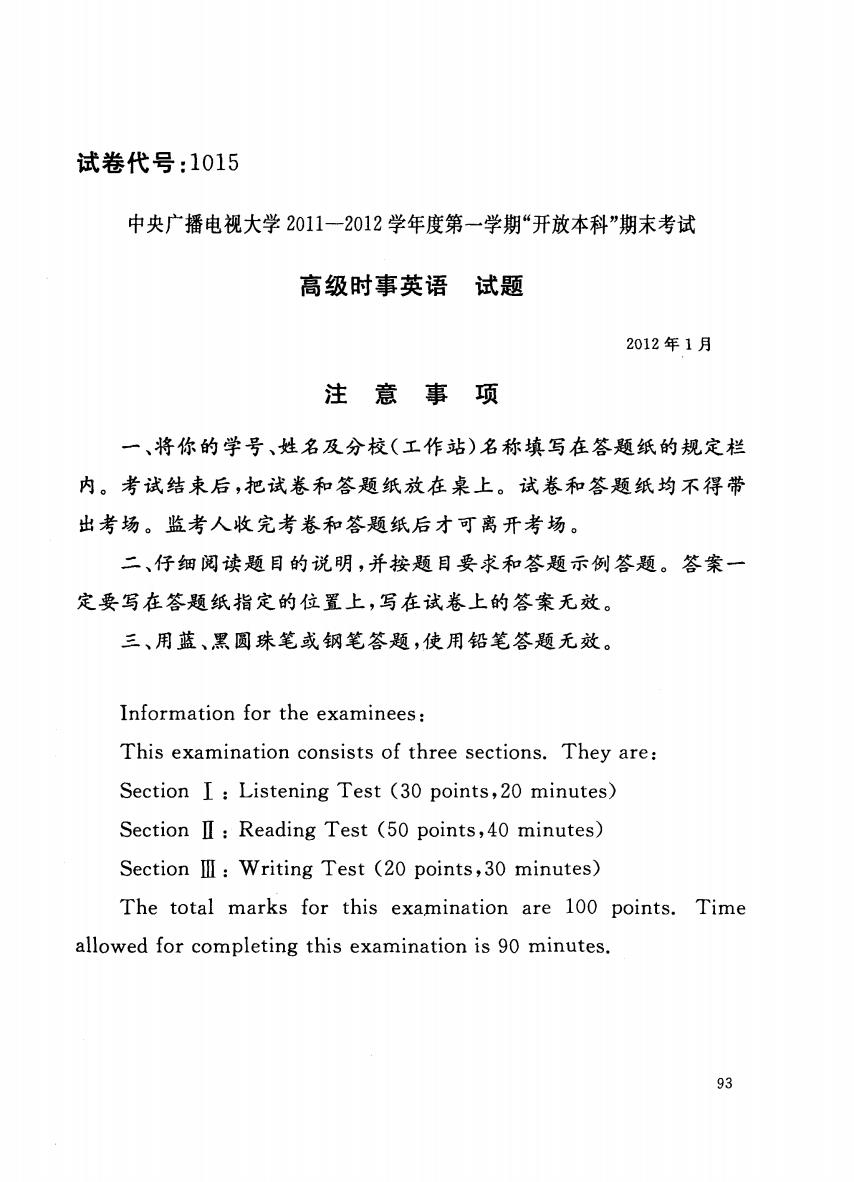
试卷代号:1015 中央广播电视大学2011一2012学年度第一学期“开放本科”期末考试 高级时事英语 试题 2012年1月 注意事项 一、将你的学号、姓名及分校(工作站)名称填写在答题纸的规定栏 内。考试结束后,把试卷和答题纸放在桌上。试卷和答题纸均不得带 出考场。监考人收完考卷和答题纸后才可离开考场。 二、仔细阅读题目的说明,并按题目要求和答题示例答题。答案一 定要写在答题纸指定的位置上,写在试卷上的答案无效。 三、用蓝、黑圆珠笔或钢笔答题,使用铅笔答题无效。 Information for the examinees: This examination consists of three sections.They are: Section I:Listening Test (30 points,20 minutes) Section II:Reading Test (50 points,40 minutes) Section II:Writing Test (20 points,30 minutes) The total marks for this examination are 100 points.Time allowed for completing this examination is 90 minutes. 93
试卷代号 中央广播电视大学 11 2学年度第一学期"开放本科"期末考试 高级时事英语试题 2012 年1 注意事项 一、将你的学号、姓名及分校(工作站)名称填写在答题纸的规定栏 内。考试结束后,把试卷和答题纸放在桌上。试卷和答题纸均不得带 出考场。监考人收完考卷和答题纸后才可离开考场。 二、仔细阅读题目的说明,并按题目要求和答题示例答题。答案一 定要写在答题纸指定的位置上,写在试卷上的答案无效。 三、用蓝、黑圆珠笔或钢笔答题,使用铅笔答题无效。 Information for the examinees: This examination consists of three sections. They are: Section I : Listening Test (30 points,20 minutes) Section II : Reading Test (50 points,40 minutes) Section Writing Test (20 points,30 minutes) The total marks for this examination are 100 points. Time allowed for completing this examination is 90 minutes. 93
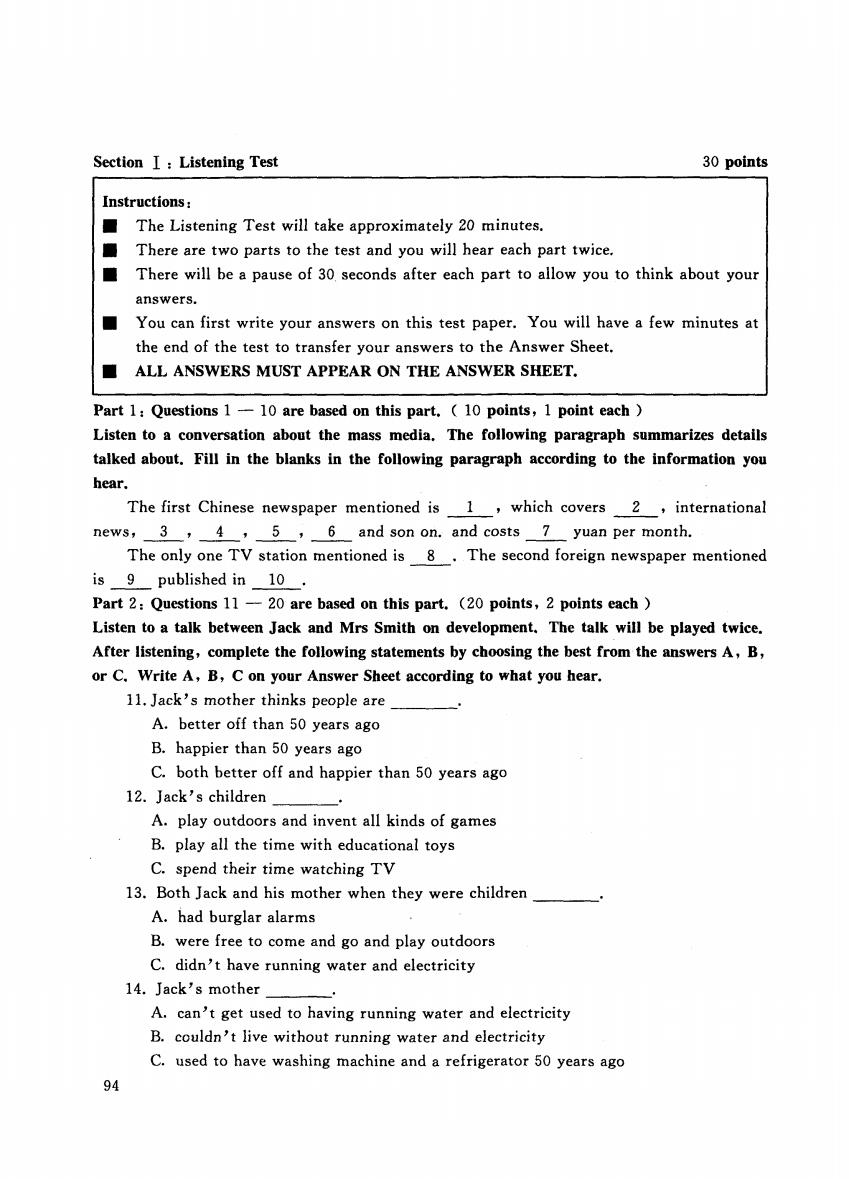
Section I Listening Test 30 points Instructions: The Listening Test will take approximately 20 minutes. There are two parts to the test and you will hear each part twice. There will be a pause of 30 seconds after each part to allow you to think about your answers. ■ You can first write your answers on this test paper.You will have a few minutes at the end of the test to transfer your answers to the Answer Sheet. ALL ANSWERS MUST APPEAR ON THE ANSWER SHEET. Part 1:Questions 1-10 are based on this part.10 points,1 point each Listen to a conversation about the mass media.The following paragraph summarizes details talked about.Fill in the blanks in the following paragraph according to the information you hear. The first Chinese newspaper mentioned is 1,which covers 2,international news,3,4,5,6 and son on.and costs 7 yuan per month. The only one TV station mentioned is 8.The second foreign newspaper mentioned is 9 published in 10. Part 2:Questions 11-20 are based on this part.(20 points,2 points each Listen to a talk between Jack and Mrs Smith on development.The talk will be played twice. After listening,complete the following statements by choosing the best from the answers A,B, or C.Write A,B,C on your Answer Sheet according to what you hear. 11.Jack's mother thinks people are A.better off than 50 years ago B.happier than 50 years ago C.both better off and happier than 50 years ago 12.Jack's children A.play outdoors and invent all kinds of games B.play all the time with educational toys C.spend their time watching TV 13.Both Jack and his mother when they were children A.had burglar alarms B.were free to come and go and play outdoors C.didn't have running water and electricity 14.Jack's mother A.can't get used to having running water and electricity B.couldn't live without running water and electricity C.used to have washing machine and a refrigerator 50 years ago 94
Section I : Listening Test 30 points Instructions: • The Listening Test will take approximately 20 minutes. • There are two parts to the test and you will hear each part twice. • There will be a pause of 30 seconds after each part to allow you to think about your ans r s • You can first write your answers on this test paper. You will have a few minutes at the end of the test to transfer your answers to the Answer Sheet. • ALL ANSWERS MUST APPEAR ON THE ANSWER SHEET. Part 1: Qu臼tions 1 - 10 are based on this part. ( 10 points, 1 point each ) Listen to a conversation about the mass media. The following paragraph summarizes details talked abou t. Fill in the blanks in the following paragraph according to the information you hear. The first Chinese newspaper mentioned is which covers international news, 3 , 4 , 5 , 6 and son on. and costs 7 yuan per month. The only one TV station mentioned is 8 . The second foreign newspaper mentioned is 9 published in 10 Part 2: Questions 11 一20 are based on this part. (20 points, 2 points each) Listen to a talk between Jack and Mrs Smith on development. The talk will be played twice. After listening , complete the following statements by choosing the best from the answers A , B, or C. Write A, B, C on your Answer Sheet according to what you hear. 11.Jack's mother thinks people are A. better off than 50 years ago B. happier than 50 years ago C. both better off and happier than 50 years ago 12. Jack's children A. play outdoors and invent all kinds of games B. play all the time with educational toys C. spend their time watching TV 13. Both Jack and his mother when they were children A. had burglar alarms B. were free to come and go and play outdoors C. didn't have running water and electricity 14. Jack's mother A. can' t get used to having running water and electricity B. couldn' t live without running water and electricity C. used to have washing machine and a refrigerator 50 years ago 94

15.Jack A.has never owned a computer B.can't get used to having a computer C.couldn't manage now without a computer 16.Jack's mother uses A.both the telephone and a computer B.only the telephone C.only a computer 17.Jack's sister_ A.lives in Australia B.lives in Beijing C.is older than Jack 18.Jack thinks communication is easier now because A.he can spend hours on the telephone B.he can fly to Sydney in 12 hours C.he can chat online with his sister 19.Jack's mother A.will be 65 tomorrow B.is no longer so afraid of diseases C.will live 10 years longer 20.Jack's mother is A.74 years old B.75 years old C.65 years old This is the end of the Listening Test.You will have 10 minutes to transfer your answers to the Answer Sheet. SectionⅡ:Reading Test 50 points Instructions: There are three parts to the test,each including one reading passage. The test will take approximately 40 minutes. There will be NO extra time to transfer answers to the Answer Sheet;therefore,you should write ALL your answers on the Answer Sheet as you do each task. Part 1:Questions 21-30 are based on the following passage.(20 points,2 points each) Changes in Australian Education Haralambos and his colleagues(1996)have summarized the major changes in Australian education over the past two hundred years.The major issues driving their analysis are the 95
15. Jack A. has never owned a computer B. can' t get used to having a computer C. couldn' t manage now without a computer 16. Jack's mother uses A. both the telephone and a computer B. only the telephone C. only a computer 17. Jack's sister A. lives in Australia B. lives in Beijing C. is older than Jack 18. Jack thinks communication is easier now because A. he can spend hours on the telephone B. he can fly to Sydney in 12 hours C. he can chat online with his sister 19. Jack's mother A. will be 65 tomorrow B. is no longer so afraid of diseases C. will live 10 years longer 20. Jack's mother is A. 74 years old B. 75 years old C. 65 years old This is the end of the Listening Test. You will have 10 minutes to transfer your answers to the Answer Sheet. Section II : Reading Test 50 points Instructions, • There are three parts to the test , each including one reading passage. • The test will take approximately 40 minutes. • There will be NO extra time to transfer answers to the Answer Sheet; therefore , you should write ALL your answers on the Answer Sheet as you do each task. Part 1: Questions 21 - 30 are based on the following passage. (20 points, 2 points each) Changes in Australian Education Haralambos and his colleagues (1 996) have summarized the major changes in Australian education over the past two hundred years. The major issues driving their analysis are the 95
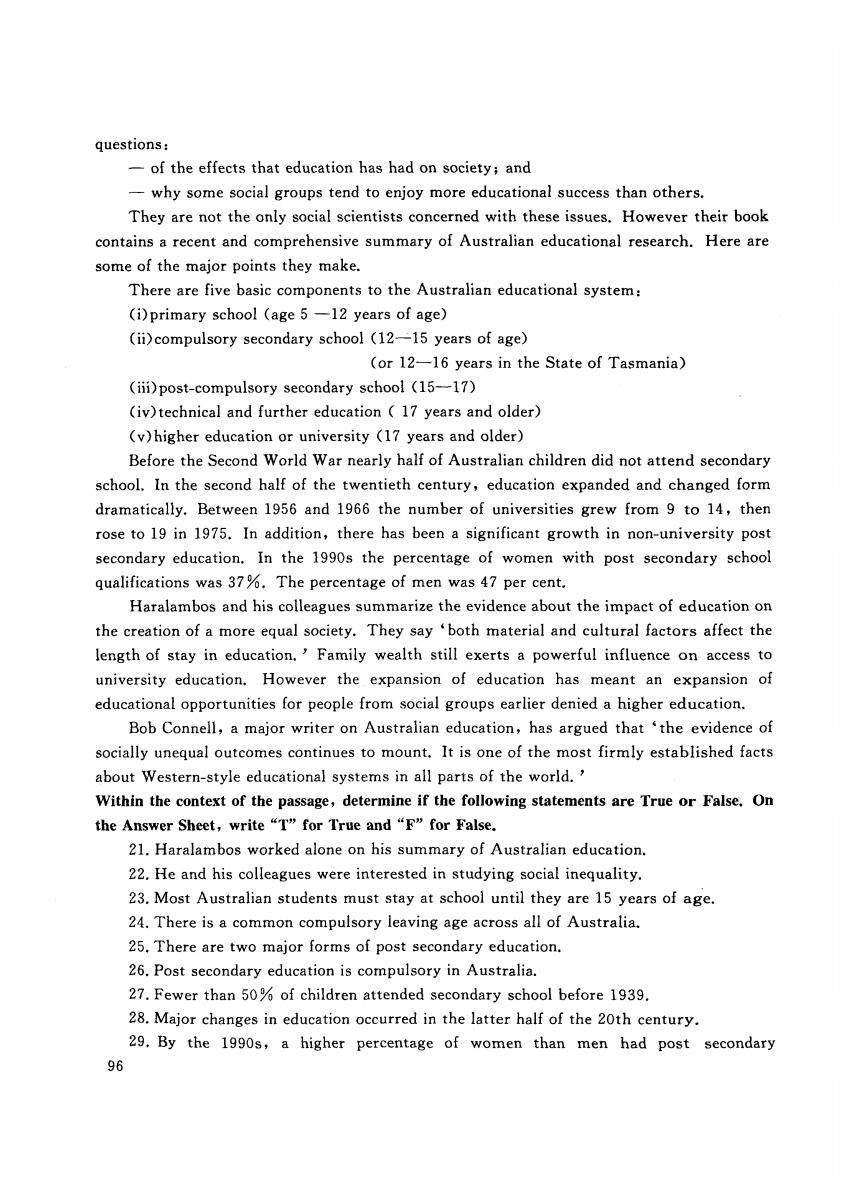
questions: -of the effects that education has had on society;and -why some social groups tend to enjoy more educational success than others. They are not the only social scientists concerned with these issues.However their book contains a recent and comprehensive summary of Australian educational research.Here are some of the major points they make. There are five basic components to the Australian educational system: (i)primary school (age 5-12 years of age) (ii)compulsory secondary school (12-15 years of age) (or 12-16 years in the State of Tasmania) (iii)post-compulsory secondary school (15-17) (iv)technical and further education 17 years and older) (v)higher education or university (17 years and older) Before the Second World War nearly half of Australian children did not attend secondary school.In the second half of the twentieth century,education expanded and changed form dramatically.Between 1956 and 1966 the number of universities grew from 9 to 14,then rose to 19 in 1975.In addition,there has been a significant growth in non-university post secondary education.In the 1990s the percentage of women with post secondary school qualifications was 37%.The percentage of men was 47 per cent. Haralambos and his colleagues summarize the evidence about the impact of education on the creation of a more equal society.They say 'both material and cultural factors affect the length of stay in education.'Family wealth still exerts a powerful influence on access to university education.However the expansion of education has meant an expansion of educational opportunities for people from social groups earlier denied a higher education. Bob Connell,a major writer on Australian education,has argued that 'the evidence of socially unequal outcomes continues to mount.It is one of the most firmly established facts about Western-style educational systems in all parts of the world.' Within the context of the passage,determine if the following statements are True or False.On the Answer Sheet,write“T”for True and“F”for False. 21.Haralambos worked alone on his summary of Australian education. 22.He and his colleagues were interested in studying social inequality. 23.Most Australian students must stay at school until they are 15 years of age. 24.There is a common compulsory leaving age across all of Australia. 25.There are two major forms of post secondary education. 26.Post secondary education is compulsory in Australia. 27.Fewer than 50%of children attended secondary school before 1939. 28.Major changes in education occurred in the latter half of the 20th century. 29.By the 1990s,a higher percentage of women than men had post secondary 96
questIOns: the effects that education has had on society; and • why some social groups tend to enjoy more educationalsuccess than others. They are not the only social scientists concerned with these issues. However their book contains a recent and comprehensive summary of Australian educational research. Here are some of the major points they make. There are five basic components to the Australian educational system: (i) primary school (age 一12 years of age) (ii) compulsory secondary school (1 2- 15 years of age) (or 12一16 years in the State of Tasmania) (iiDpost-com pulsory secondary school (1 5- 17) (iv) technical and further education ( 17 years and older) (v) higher education or university (1 7 years and older) Before the Second World War nearly half of Australian children did not attend secondary school. In the second half of the twentieth century , education expanded and changed form dramatically. Between 1956 and 1966 the number of universities grew from 9 to 14 , then rose to 19 in 1975. In addition , there has been a significant growth in non-university post secondary education. In the 1990s the percentage of women with post secondary school qualifications was 37%. The percentage of men was 47 per cent. Haralambos and his colleagues summarize the evidence about the impact of education on the creation of a more equal society. They say ‘both material and cultural factors affect the length of stay in education. ' Family wealth still exerts a powerful influence on access to university education. However the expansion of education has meant an expansion of educational opportunities for people from social groups earlier denied a higher education. Bob Connell , a major writer on Australian education , has argued that ‘ th e evidence of socially unequal outcomes continues to mount. It is one of the most firmly established facts about Western-style educational systems in all parts of the world. ' Within the context of the passage , determine if the following statements are True or False. On the Answer Sheet, write "T" for True and "F" for False. 21. Haralambos worked alone on his summary of Australian education. 22. He and his colleagues were interested in studying social inequality. 23. Most Australian students must stay at school until they are 15 years of age. 24. There is a common compulsory leaving age across all of Australia. 25. There are two major forms of post secondary education. 26. Post secondar
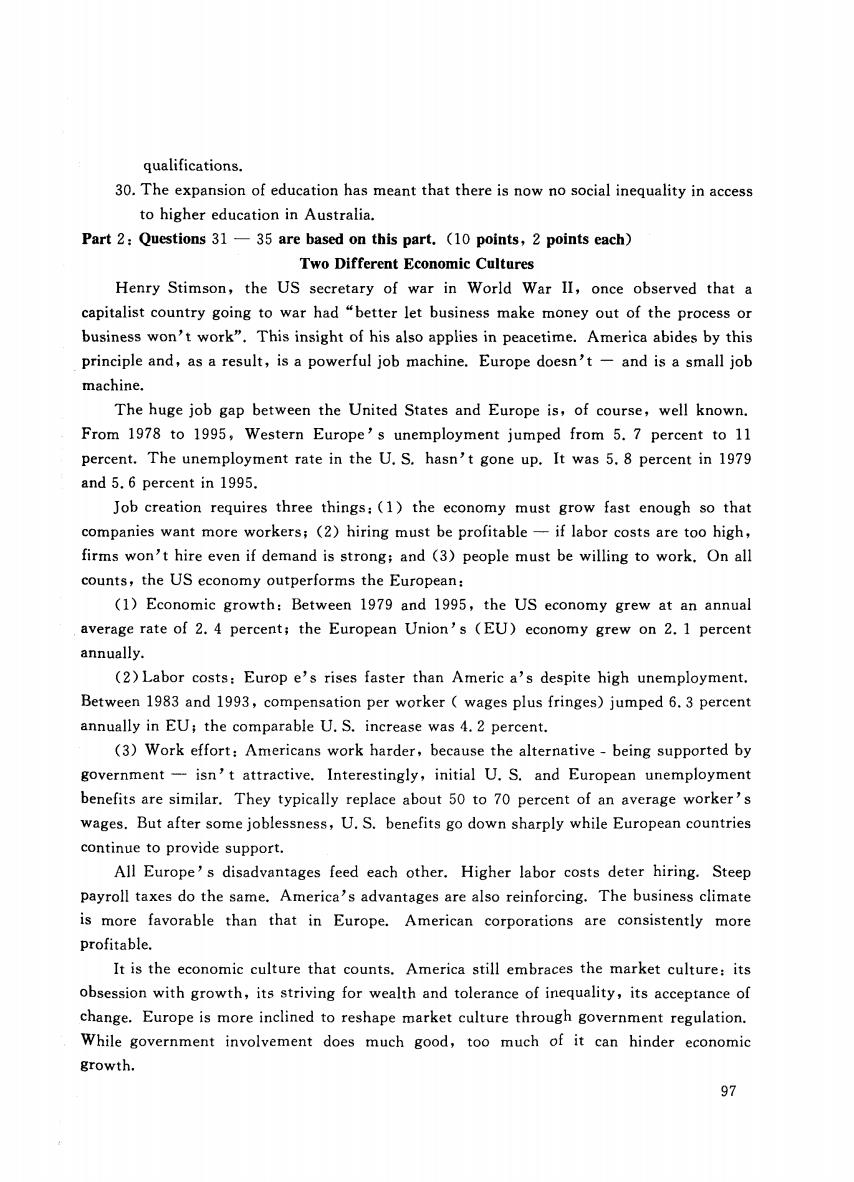
qualifications. 30.The expansion of education has meant that there is now no social inequality in access to higher education in Australia. Part 2:Questions 31-35 are based on this part.(10 points,2 points each) Two Different Economic Cultures Henry Stimson,the US secretary of war in World War II,once observed that a capitalist country going to war had "better let business make money out of the process or business won't work".This insight of his also applies in peacetime.America abides by this principle and,as a result,is a powerful job machine.Europe doesn't -and is a small job machine. The huge job gap between the United States and Europe is,of course,well known. From 1978 to 1995,Western Europe's unemployment jumped from 5.7 percent to 11 percent.The unemployment rate in the U.S.hasn't gone up.It was 5.8 percent in 1979 and 5.6 percent in 1995. Job creation requires three things:(1)the economy must grow fast enough so that companies want more workers;(2)hiring must be profitable-if labor costs are too high, firms won't hire even if demand is strong;and (3)people must be willing to work.On all counts,the US economy outperforms the European: (1)Economic growth:Between 1979 and 1995,the US economy grew at an annual average rate of 2.4 percent;the European Union's (EU)economy grew on 2.1 percent annually. (2)Labor costs:Europ e's rises faster than Americ a's despite high unemployment. Between 1983 and 1993,compensation per worker wages plus fringes)jumped 6.3 percent annually in EU;the comparable U.S.increase was 4.2 percent. (3)Work effort:Americans work harder,because the alternative-being supported by government-isn't attractive.Interestingly,initial U.S.and European unemployment benefits are similar.They typically replace about 50 to 70 percent of an average worker's wages.But after some joblessness,U.S.benefits go down sharply while European countries continue to provide support. All Europe's disadvantages feed each other.Higher labor costs deter hiring.Steep payroll taxes do the same.America's advantages are also reinforcing.The business climate is more favorable than that in Europe.American corporations are consistently more profitable. It is the economic culture that counts.America still embraces the market culture:its obsession with growth,its striving for wealth and tolerance of inequality,its acceptance of change.Europe is more inclined to reshape market culture through government regulation. While government involvement does much good,too much of it can hinder economic growth. 97
qualifications. 30. The expansion of education has meant that there is now no social inequality in access to higher education in Australia. Part 2: Questions 31 - 35 are based on this part. (1 0 points, 2 points each) Two Different Economic Cultures Henry Stimson , the US secretary of war in World War II , once observed that a capitalist country going to war had "better let business make money out of the process or business won' t work". This insight of his also applies in peacetime. America abides by this principle and , as a result , is a powerful job machine. Europe doesn' t - and is a small job machine. The huge job gap between the United States and Europe is , of course , well known. From 1978 to 1995 , Western Europe' s unemployment jumped from 5. 7 percent to 11 percent. The unemployment rate in the U. S. hasn' t gone up. It was 5. 8 percent in 1979 and 5.6 percent in 1995. Job creation requires three things: (1) the economy must grow fast enough so that companies want more workers; (2) hiring must be profitable if labor costs are too high , firms won' t hire even if demand is strong; and (3) people must be willing to work. On all counts, the US economy outperforms the European: (1) Economic growth: Between 1979 and 1995 , the US economy grew at an annual average rate of 2.4 percent; the European Union' s (EU) economy grew on 2.1 percent annually. (2) Labor costs: Europ e' s rises faster than Americ a' s despite high unemployment. Between 1983 and 1993 , compensation per worker ( wages plus fringes) jumped 6.3 percent annually in EU; the comparable U. S. increase was 4. 2 percent. (3) Work effort: Americans work harder, because the alternative - being supported by government 一isn' t attractive. Interestingly , initial U. S. and European unemployment benefits are similar. They typically replace about 50 to 70 percent of an average worker' s wages. But after some joblessness, U. S. benefits go down sharply while European countries continue to provide support. All Europe' s disadvantages feed each other. Higher labor costs deter hiring. Steep payroll taxes do the same. America's advantages are also reinforcing. The business climate is more favorable than that in Europe. American corporations are consistently more profitable. It is the economic culture that counts. America still embraces the market culture: its obsession with growth , its striving for wealth and tolerance of inequality , its acceptance of change. Europe is more incli 97

Complete the following statements by choosing the best from the answers A,B or C.Write A,B or C on your Answer Sheet. 31.Which of the following would be the best peacetime version of Stimson's remark? A.Business is a powerful job machine. B.Business must make more money in peacetime. C.Markets should be left fairly free. 32.Which of the following doesn't help to create jobs according to the third paragraph? A.Fairly low labor costs. B.Demand of labor force. C.Fast economic growth. 33.According to the passage,which of the following is not a feature of the market culture? A.Working hard to accumulate wealth. B.Preoccupation with development. C.Absolute equality for every citizen. 34.European economic culture differs from that of the U.S.in that A.it advocates free market system B.it opposes the free market system C.it faces too much government intervention 35.America embraces the market culture,because A.the economy grew very fast B.the economy grew very slow C.it hinders economic growth Part 3:Questions 36-40 are based on this part.(20 points,4 points each) British Womanhood The recent publication of 'Social Focus on Women',the Central Statistical Office's first comprehensive report on British womanhood,has provided a useful occasion for the reopening of discussion of lots of our old favorite topics.The findings of the report may be disappointing for those who had glorious dreams of change in the seventies but,for most women living in present day Britain,there are no surprises. Few women would deny that they are better of than their mothers were.Today's 30 year-old woman is far more likely to have college qualifications,to have her own job and to own her own home.53%of women today have driving licenses compared with only 29%in 1975.The picture could start to look quite rosy if we ignored all the negative data! Inequalities at home and work persist and women's earnings still lag far behind those of men.'Social Focus on Women'makes it clear that the improvements in women's lives are overshadowed by continuing injustices. Twenty years or so ago,as the Women's Liberation Movement increased awareness of women's rights and sexual equality,the Sex Discrimination Act was passed in Britain, outlawing different pay scales for men and women who did the same jobs and discriminatory 98
Complete the following statements by choosing the best from the answers A, B or C. Write A, B or C on your Answer Sheet. 31. Which of the following would be the best peacetime version of Stimson's remark? A. Business is a powerful job machine. B. Business must make more money in peacetime. C. Markets should be left fairly free. 32. Which of the following doesn't help to create jobs according to the third paragraph? A. Fairly low labor costs. B. Demand of labor force. C. Fast economic growth. 33. According to the passage , which of the following is not a feature of the market culture? A. Working hard to accumulate wealth. B. Preoccupation with development. C. Absolute equality for every citizen. 34. European economic culture differs from that of the U. S. in that A. it advocates free market system B. it opposes the free market system C. it faces too much government intervention 35. America embraces the market culture , because A. the economy grew very fast B. the economy grew very slow C. it hinders economic growth Part 3: Questions 36 - 40 are based on this part. (20 points, 4 points each) British Womanhood The recent publication of ‘ Social Focus on Women' , the Central Statistical Office' s first comprehensive report on British womanhood , has provided a useful occasion for the reopening of discussion of lots of our old favorite topics. The findings of the report may be disappointing for those who had glorious dreams of change in the seventies but , for most women living in present day Britain , there are no surprises. Few women would deny that they are better of than their mothers were. Today' s 30 year-old woman is far more likely to have college qualifications , to have her own job and to own her own home. 53% of women today have driving licenses compared with only 29% in 1975. The picture could start to look quite rosy if we ignored all the negative data! Inequalities at home and work persist and women' s earnings still lag far behind those of men. ‘Social Focus on Women' makes it clear that the improvements in women' s lives are overshadowed by continuing injustices. Twenty years or so ago , as the Women's Liberation Movement increased awareness of women' s rights and sexual equality , the Sex Discrimination Act was passed in Britain , outlawing different pay scales for men and women who did the same jobs and discriminatory 98
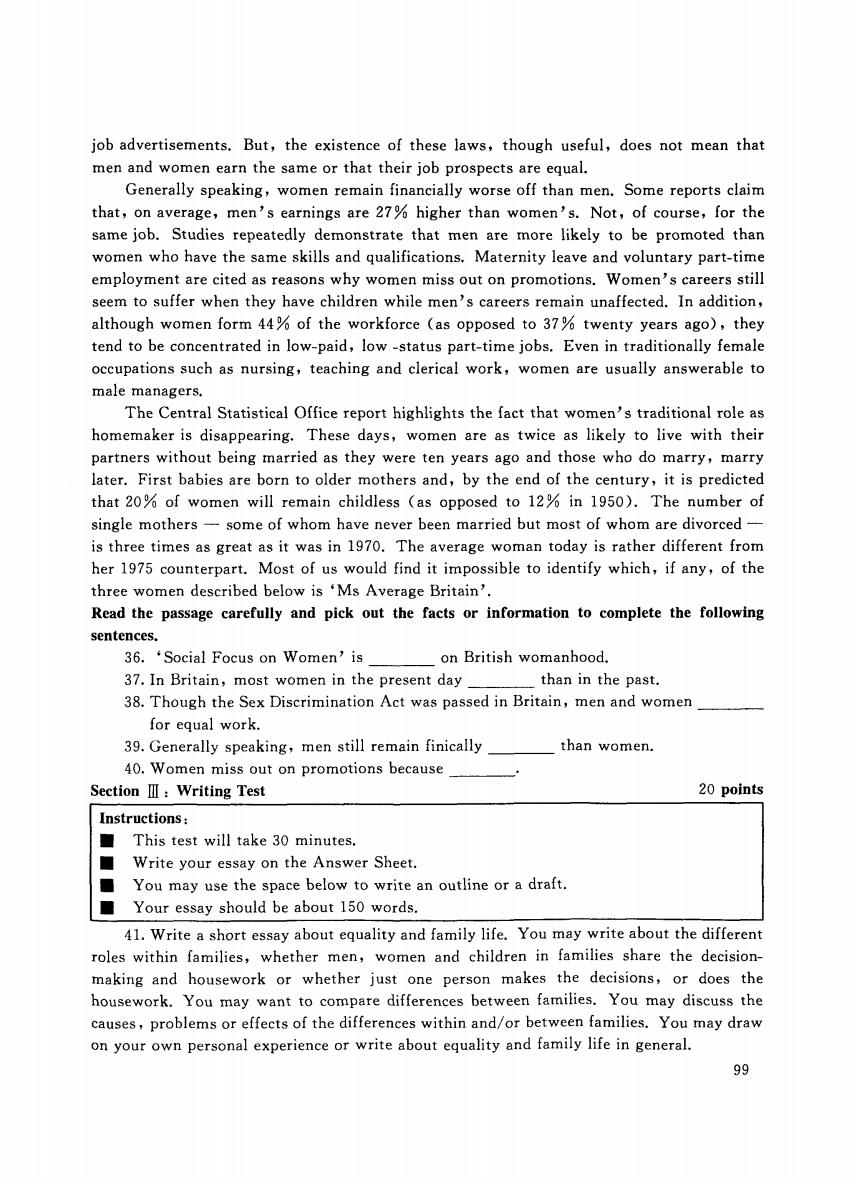
job advertisements.But,the existence of these laws,though useful,does not mean that men and women earn the same or that their job prospects are equal. Generally speaking,women remain financially worse off than men.Some reports claim that,on average,men's earnings are 27%higher than women's.Not,of course,for the same job.Studies repeatedly demonstrate that men are more likely to be promoted than women who have the same skills and qualifications.Maternity leave and voluntary part-time employment are cited as reasons why women miss out on promotions.Women's careers still seem to suffer when they have children while men's careers remain unaffected.In addition, although women form 44%of the workforce (as opposed to 37%twenty years ago),they tend to be concentrated in low-paid,low-status part-time jobs.Even in traditionally female occupations such as nursing,teaching and clerical work,women are usually answerable to male managers. The Central Statistical Office report highlights the fact that women's traditional role as homemaker is disappearing.These days,women are as twice as likely to live with their partners without being married as they were ten years ago and those who do marry,marry later.First babies are born to older mothers and,by the end of the century,it is predicted that 20%of women will remain childless (as opposed to 12%in 1950).The number of single mothers-some of whom have never been married but most of whom are divorced- is three times as great as it was in 1970.The average woman today is rather different from her 1975 counterpart.Most of us would find it impossible to identify which,if any,of the three women described below is 'Ms Average Britain'. Read the passage carefully and pick out the facts or information to complete the following sentences. 36.‘Social Focus on Women’is on British womanhood. 37.In Britain,most women in the present day than in the past. 38.Though the Sex Discrimination Act was passed in Britain,men and women for equal work. 39.Generally speaking,men still remain finically than women. 40.Women miss out on promotions because SectionⅢ:Writing Test 20 points Instructions: This test will take 30 minutes. Write your essay on the Answer Sheet. You may use the space below to write an outline or a draft. Your essay should be about 150 words. 41.Write a short essay about equality and family life.You may write about the different roles within families,whether men,women and children in families share the decision- making and housework or whether just one person makes the decisions,or does the housework.You may want to compare differences between families.You may discuss the causes,problems or effects of the differences within and/or between families.You may draw on your own personal experience or write about equality and family life in general. 99
job advertisements. But , the existence of these laws, though useful , does not mean that men and women earn the same or that their job prospects are equal. Generally speaking , women remain financially worse off than men. Some reports claim that , on average , men' s earnings are 27% higher than women 气. Not , of course , for the same job. Studies repeatedly demonstrate that men are more likely to be promoted than women who have the same skills and qualifications. Maternity leave and voluntary part-time employment are cited as reasons why women miss out on promotions. Women' s careers still seem to suffer when they have children while men's careers remain unaffected. In addition , although women form 44% of the workforce (as opposed to 37 % twenty years ago) , they tend to be concentrated in low-paid , low -status part-time jobs. Even in traditionally female occupations such as nursing , teaching and clerical work , women are usually answerable to male managers. The Central Statistical Office report highlights the fact that women' s traditional role as homemaker is disappearing. These days, women are as twice as likely to live with their partners without being married as they were ten years ago and those who do marry , marry later. First babies are born to older mothers and , by the end of the century , it is predicted that 20% of women will remain childless (as opposed to 12% in 1950). The number of single mothers 一some of whom have never been married but most of whom are divorced is three times as great as it was in 1970. The average woman today is rather different from her 1975 counterpart. Most of us would find it impossible to identify which , if any , of the three women described below is ‘Ms Average Britain'. Read the passage carefully and pick out the facts or information to complete the following sentences. 36. ‘Social Focus on Women' is on British womanhood. 37. In Britain , most women in the present day 一一一 than in the past. 38. Though the Sex Discrimination Act was passed in Britain , men and women for equal work. 39. Generally speaking , men still remain finically than women. 40. Women miss out on promotions because Section III: Writing Test 20 points Instructions: • This test will take 30 minutes. your essay on the Answer Sheet. • You may use the space below to write an outline or a draft. o u essay should be about 150 words. 41. Write a short essay about equality and family life. You may write about the different roles 99
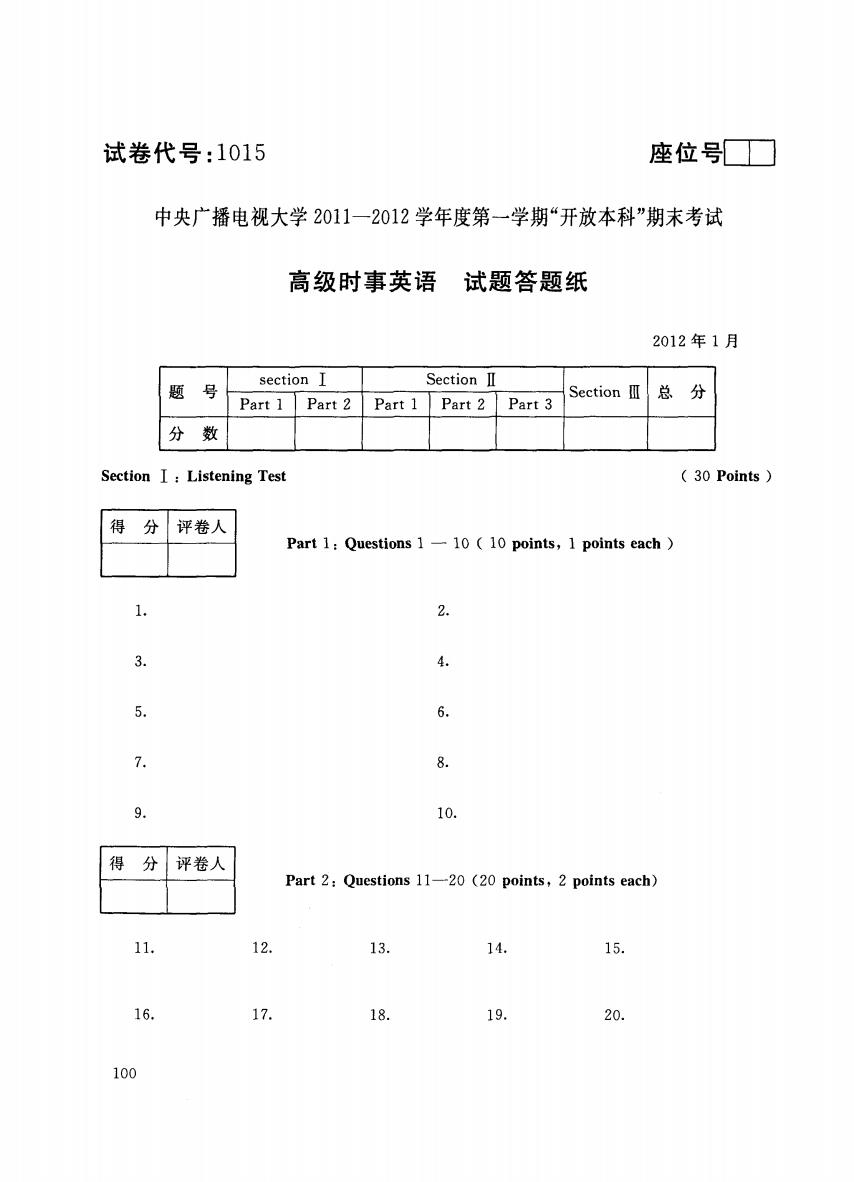
试卷代号:1015 座位号■■ 中央广播电视大学2011一2012学年度第一学期“开放本科”期末考试 高级时事英语试题答题纸 2012年1月 题 section I SectionⅡ 号 SectionⅢ 总 分 Part 1 Part 2 Part 1 Part 2 Part 3 分 数 Section I:Listening Test (30 Points 得 分 评卷人 Part 1:Questions 1-10 10 points,1 points each 2. 3. 4. 6. 7. 8. 9. 10. 得分 评卷人 Part 2:Questions 11-20(20 points,2 points each) 11. 12. 13. 14. 15. 16. 17. 18. 19. 20. 100
试卷代号 座位号OJ 中央广播电视大学 11 2学年度第一学期"开放本科"期末考试 高级时事英语试题答题纸 2012 年1 section I Section II Section ill Part 1 Part 2 Part 1 Part 2 Part 3 Section I : Listening Test ( 30 Points ) |得分|评卷人 11 叫ons 1 - 10 (问。比 poi川ch ) 1. 2. 3. 4. 5. 6. 7. 8. 9. 10. |得分|评卷人| I 1 1 Part 2: Questions 11-20 (20 points, 2 points each) 11. 16. 100 12. 17. 13. 18. 14. 19. 15. 20
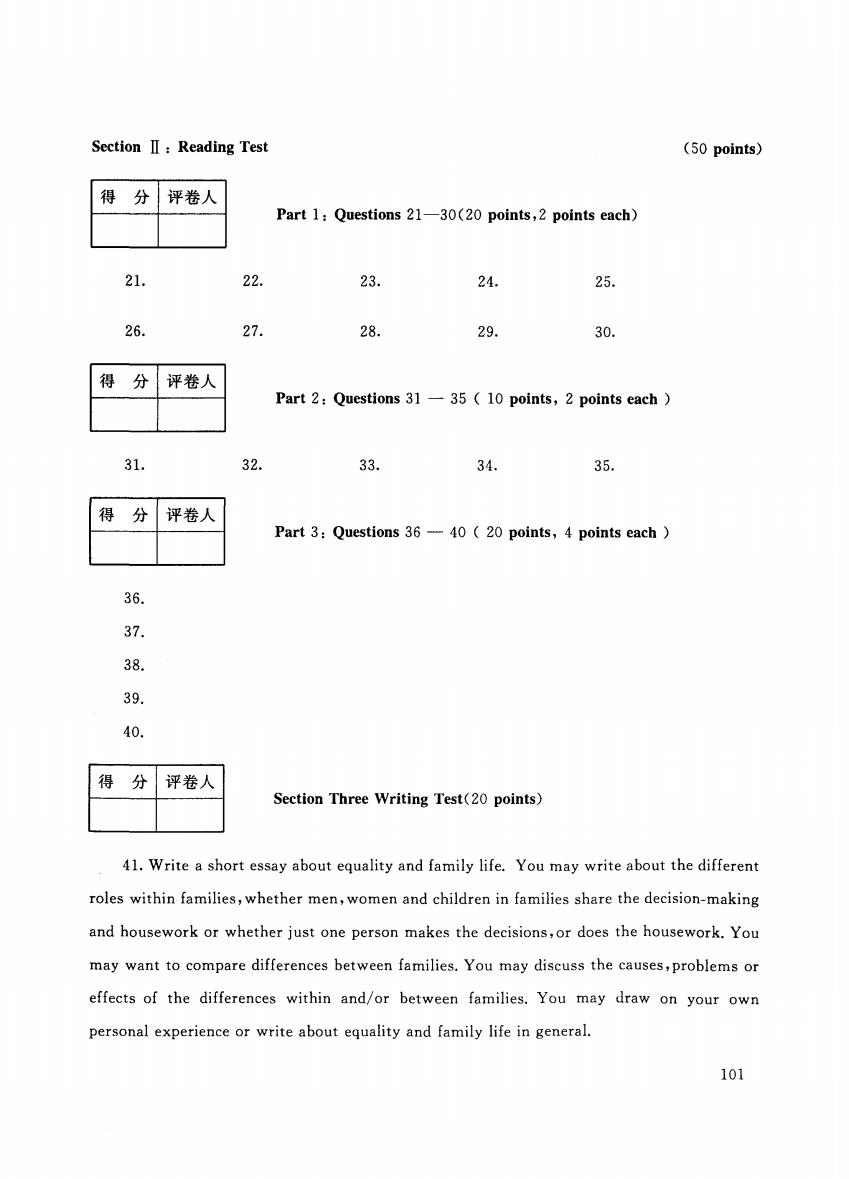
SectionⅡ:Reading Test (50 points) 得分 评卷人 Part 1:Questions 21-30(20 points,2 points each) 21. 22. 23. 24. 25. 26. 27. 28. 29. 30. 得 分 评卷人 Part 2:Questions 31-35(10 points,2 points each 31. 32. 33. 34. 35. 得分 评卷人 Part 3:Questions 36-40 20 points,4 points each 36 37. 38. 39. 40. 得分 评卷人 Section Three Writing Test(20 points) 41.Write a short essay about equality and family life.You may write about the different roles within families,whether men,women and children in families share the decision-making and housework or whether just one person makes the decisions,or does the housework.You may want to compare differences between families.You may discuss the causes,problems or effects of the differences within and/or between families.You may draw on your own personal experience or write about equality and family life in general. 101
Section II : Reading Test (50 points) |得分|评卷人 nPart 1: Questions 21-30( ,2 poi…d 21. 26. 22. 27. 23. 28. 24. 29. 25. 30. Section Three 飞"'riting Test(20 points) Part 3: Questions 36 - 40 ( 20 points, 4 points each) Part 2: Questions 31 - 35 ( 10 points, 2 points each ) 31. 32. 36. 37. 38. 39. 40. 分|评卷人 33. 34. 35. 41. Write a short essay about equality and family life. You may write about the different roles within families ,whether men ,women and children in families share the decision-making and housework or whether just one person makes the decisions,or does the housework. You may want to compare differences between families. You may discuss the causes,problems or effects of the differences within and/or between families. You may draw on your own personal experience or write about equality and family life in general. 101
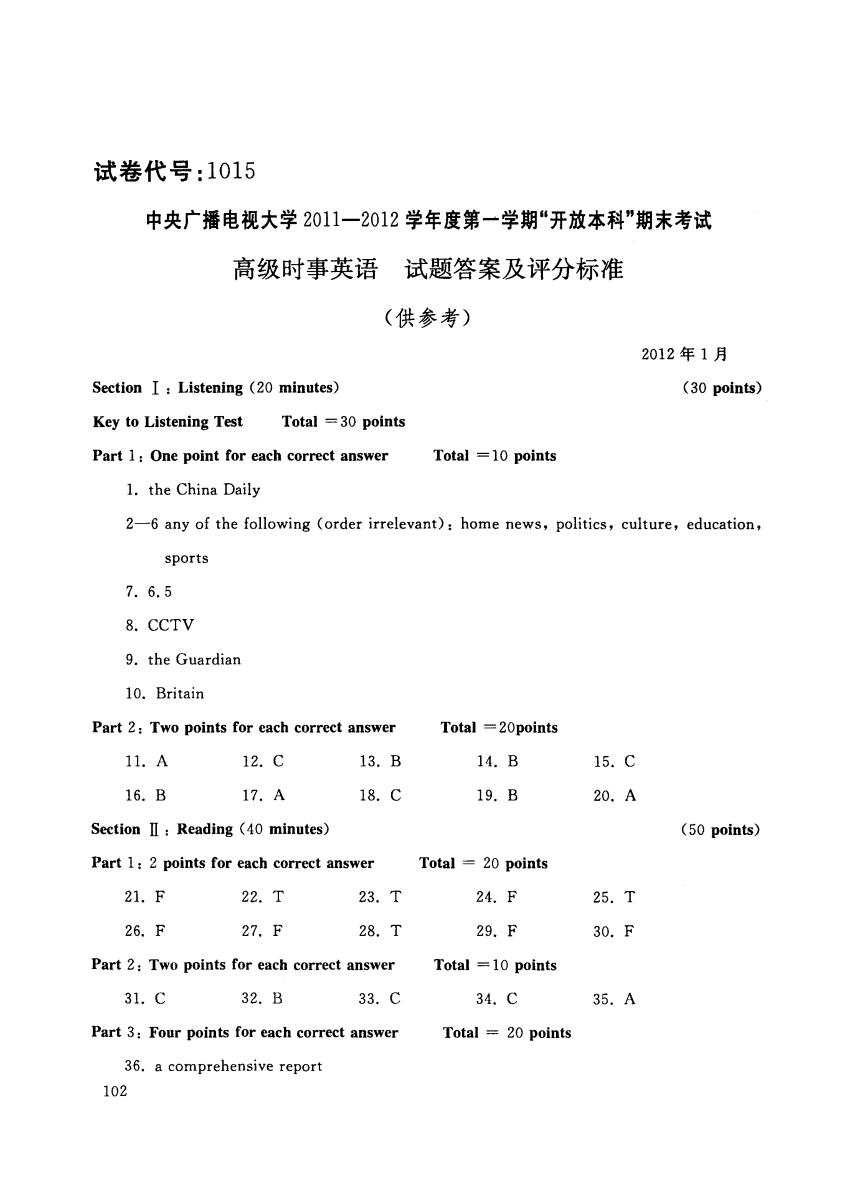
试卷代号:1015 中央广播电视大学2011一2012学年度第一学期“开放本科”期末考试 高级时事英语 试题答案及评分标准 (供参考) 2012年1月 Section I:Listening (20 minutes) (30 points) Key to Listening Test Total =30 points Part 1:One point for each correct answer Total =10 points 1.the China Daily 2-6 any of the following (order irrelevant):home news,politics,culture,education, sports 7.6.5 8.CCTV 9.the Guardian 10.Britain Part 2:Two points for each correct answer Total =20points 11.A 12.C 13.B 14.B 15.C 16.B 17.A 18.C 19.B 20.A SectionⅡ:Reading(40 minutes). (50 points) Part 1:2 points for each correct answer Total =20 points 21.F 22.T 23.T 24.F 25.T 26.F 27.F 28.T 29.F 30.F Part 2:Two points for each correct answer Total =10 points 31.C 32.B 33.C 34.C 35.A Part 3:Four points for each correct answer Total =20 points 36.a comprehensive report 102
试卷代号 中央广播电视大学 0 11 2学年度第-学期"开放本科"期末考试 高级时事英语试题答案及评分标准 (供参考) 2012 年1 Section I : Listening (20 minutes) (30 points) Key to Listening Test Total = 30 points Part 1: One point for each correct answer 1. the China Daily Total = 10 points 2-6 any of the following (order irrelevant): home news, politics, culture , education , sports 7. 6.5 8. CCTV 9. the Guardian 10. Britain Part 2: Two points for each correct answer Total = 20points 11. A 16. B 12. C 17. A 13. B 18. C 14. B 19. B 15. C 20. A Section n: Reading (40 minutes) Part 1: 2 points for each correct answer Total = 20 points (50 points) 21. F 26. F 22. T 27. F 23. T 28. T 24. F 29. F 25. T 30. F Part 2: Two points for each correct answer Total = 10 points 31. C 32. B 33. C 34. C 35. A Part 3: Four points for each correct answer 36. a comprehensive report 102 Total = 20 points